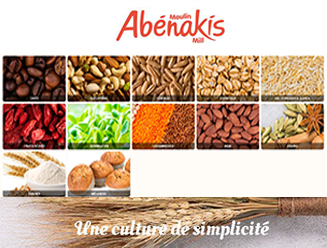Where does flour come from?
Flour is obtained by grinding wheat or other grains such as rye, spelled, kamut, oats, buckwheat and barley. You can obviously make bread by combining several cereals. These are called multigrain breads which are typically made from 80% wheat flour and a maximum of 20% a mixture of other grains. Most multigrain breads are made from 3 or 4 grains, but some contain up to 16 different grains!
Most sourdough breads are made from grains, such as wheat, which contain a lot of gluten, a protein that gives the dough its elasticity. The cereal used determines the taste of the bread: oatmeal, buckwheat or spelled flour makes oatmeal, buckwheat or spelled bread.
It is the quality of the wheat that determines the quality of the flour. The better the flour, the better the gluten and therefore the better the bread. Wheat flour is the richest in gluten, which means that the more wheat flour there is in the dough, the more cells there will be, making the bread lighter. Conversely, when the flour contains less gluten, the bread is denser and keeps longer. Soft wheat flour contains little gluten and is more suitable for baking. Durum wheat flour, especially durum wheat, contains more gluten and is ideal for baking.
All-purpose white flour is made by grinding and blending various varieties of durum and soft wheat. In Canada, it is mandatory to fortify white flour with folic acid, iron and vitamin B, making it a nutritious choice for a host of uses, as the name suggests.
Bleached flour is artificially bleached, usually with food additives that contain calcium or phosphorus. The bread then tends to be lighter and bulkier, with a finer grain and a paler color. Gluten is also more elastic, which provides better cooking results.
Unbleached flour is naturally aged and contains no food additives or bleach. It whitens a little, but remains cream in color.
Whole grain oatmeal is a staple food that provides a healthy blend of carbohydrates, fat, and protein in addition to vitamins B6, B1, E, calcium, and iron.
Enriched wheat flour is used to make enriched white bread. Since it is forbidden to add vitamins and minerals directly to bread, the nutrients in fortified bread come from its flour.
Whole wheat flour has the highest content of dietary fiber, approximately 4 g per 60 ml (¼ cup). Whole wheat flour can be substituted for white flour in most recipes, but sometimes it may be necessary to increase the amount slightly. The end product will be more nutritious, but it will be darker, taste more pronounced and be less bulky. The higher concentration of bran causes volume loss because the bran contains an enzyme that decreases the elasticity of gluten. To obtain lighter products, it is recommended to sift the wheat flour a few times before using it, taking care to reintegrate the bran collected in the sieve into the flour. It can be used to make bread and pastries that do not require elasticity such as shortcrust, sponge cake, shortbread or cookie dough. Whole wheat flour should be stored in the refrigerator.
Baker’s flour is made from soft wheat and is rich in gluten; therefore easily bread-making. Gluten is also found in rye flour and spelled flour
Soft wheat flour is used to make muffins and pie dough.
Durum wheat flour is a whole flour that is used in pancakes and pasta making. It is best to sift it several times to bake bread.
Oatmeal flour is very rich in gluten, this protein essential to the success of traditional bakery specialties. It facilitates cooking, helps the dough to rise, improves its elasticity and determines its softness. Perfect for breads, brioches, pastries or choux pastry, but avoid when shaping a pie dough, on the other hand, which may shrink when baking!
Cake flour is made exclusively from very finely ground soft wheat. It is very refined because it always comes from the latest grinds. Since it contains more starch and less protein and gluten, it makes light cakes, but it is not recommended for sourdough breads.
Baking flour is made from soft wheat, but sometimes from durum wheat. Low in gluten, it is finely ground, but without reaching lightness.
Sources :
https://www.metro.ca/produits-a-decouvrir/boulangerie/nos-pains-patisseries-et-farines/farine-101-guide-des-different-type-et-usages





